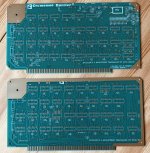Ansgar Kueckes
Member
- Joined
- Feb 11, 2024
- Messages
- 48
New version 2.0 of the Dazzler test utility available. Please check https://github.com/akueckes/Cromemco-Dazzler-RevD.
I've fixed some minor issues and also added the capability for the playback of video clips. Hope it is working with real hardware. The playback function is using the vertical sync flag from the Dazzler for timing and in order to avoid screen garbage. Again, only BDOS is required, both 8080 and Z80 supported.
Have fun
I've fixed some minor issues and also added the capability for the playback of video clips. Hope it is working with real hardware. The playback function is using the vertical sync flag from the Dazzler for timing and in order to avoid screen garbage. Again, only BDOS is required, both 8080 and Z80 supported.
Have fun

